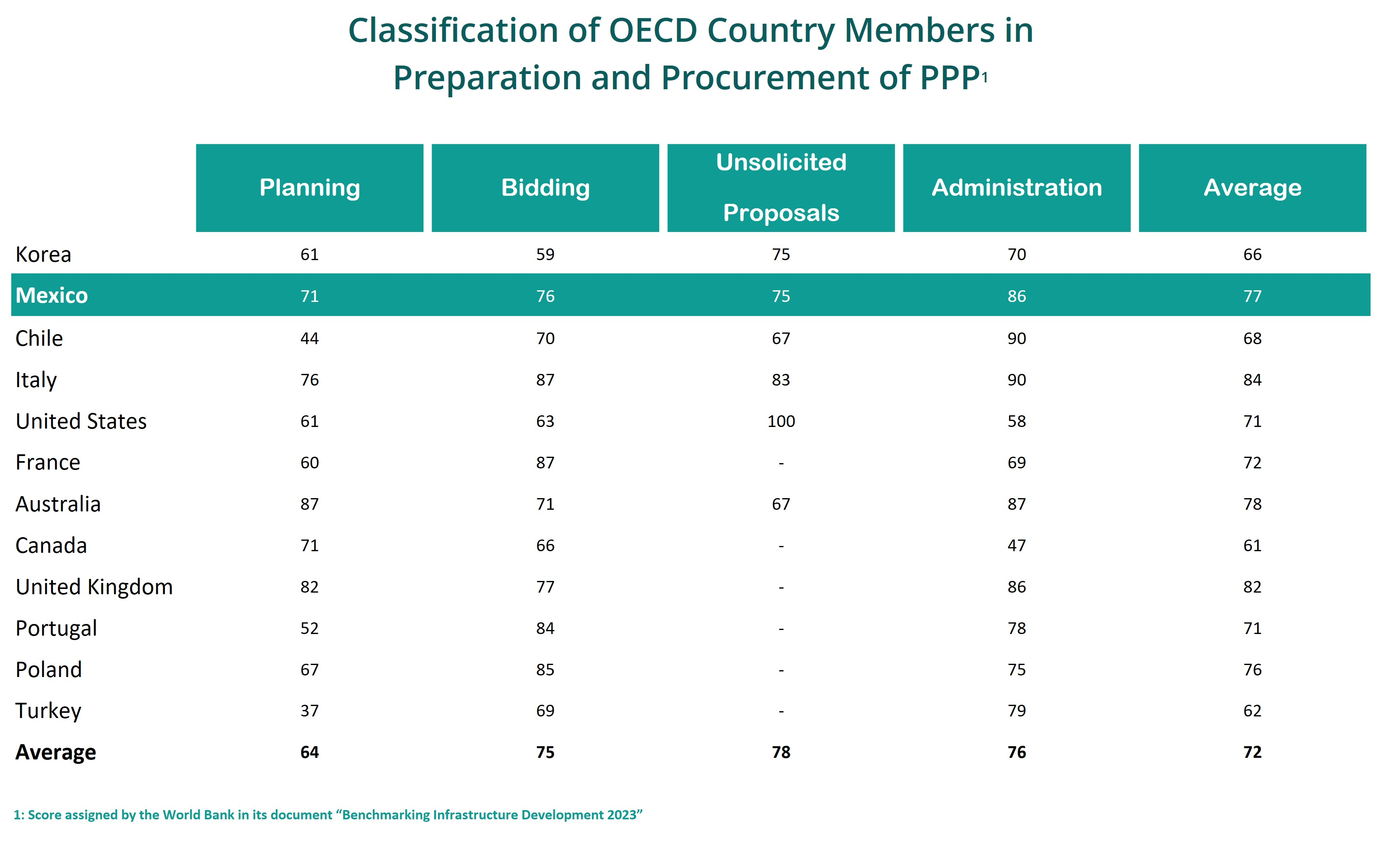Last review date: March, 2025
Attractive Destination for Investment in Infrastructure
Mexico is considered an attractive destination for private investment in infrastructure for the following reasons:
Commitment to Invest in Infrastructure
Mexico’s government is committed to promote the development of infrastructure, as well as to maintain and improve the existing one to encourage: 1) a balanced regional development; 2) a sustainable urban development; and, 3) the logistic integration of the country and an improvement in its interconnectivity. Through the development of quality infrastructure in the strategic sectors of the country, it is sought to turn Mexico into a global logistics platform with high added value, thereby increasing competitiveness, productivity and prosperity at the national level. This is reflected in the following actions and sectors. This effort is demonstrated with the following actions:
Concessioned Highways and Bridges
Digital map with the georeference of the country’s road infrastructure that shows in great detail the main highways and concessioned bridges. The current information is updated until 2019
Rural Roads and Feeder Roads Infrastructure Conservation Program 2025
Conservation and reconstruction works of rural roads and feeder roads, as well as carrying out the improvement of the road surface of selected rural roads.
National Roads Network
It integrates the total paved network and an important part of the unpaved roads in Mexico, the roads of the urban and rural towns with which they connect, river and maritime routes where vehicles are transshipped and, additionally, transport interconnection services such as airports, ports, railway stations, customs, bridges and tunnels, recreational and recreational sites, sites of interest for tourism, among others.

The Mexico-Toluca commuter rail, the first high-speed train in Latin America, has a 87% progress as of 2021, and will transport 230,000 passengers daily.
On August 18th, 2016 the Railway Transportation Regulatory Agency (“Agencia Regulatora del Transporte Ferroviario”) was created, It’s main objective is to regulate, promote, overlook and verify construction, operation, exploitation, and maintenance of railroad infrastructure.



These numbers reveal a diversified distribution of power generation capacity in Mexico, with significant participation of both the CFE and the private sector, contributing significantly to the country’s energy infrastructure.



The government’s actions increased the coverage and improved the quality of drinking water services, sewage and sanitation.
Currently there is a 95% drinking water coverage.
Between December 2012 and June 2018, 387 water treatment plants entered in operation, out of which 342 were new and 45 rehabilitated.
The Mexican Government’s investments in infrastructure reflects an evident ongoing commitment to foster the country’s economic development:
The World Bank highlight Mexico’s capacity to prepare, procure and manage public-private partnerships.
In its document “Benchmarking Infrastructure Development 2023” the World Bank places Mexico as one of most prepared countries in this matters, even when compared to OECD members, and in the different stages places Mexico above the average:
Through its tool Infracompass, highlights that “Emerging economies are catching up with developed countries in terms of the quality of their infrastructure, with the list of top improvers over the past decade dominated by emerging countries. Central to this strong performance is that many emerging countries have seen rapid policy development, including:
- better governance through lowering corruption levels and enhancing the rule of law
- improved regulatory quality
- simplifying permit procedures and land administration.”

Outlined Strategy for the Development of Infrastructure Projects
In order to provide long term visibility to investors, Mexico has in place a series of plans and programs of national coverage that include a strategic vision of each sector, depending on its specific conditions, participants, and environment.
This planning documents provide information of the current situation of each sector, its position when compared to same sectors in the rest of the world, as well as its objectives and actions to be taken in the short, medium and long term.
This document governs the programs and budgets of the Federal Public Administration, and includes the government’s vision, strategies, and actions to be implemented during the current administration, as well as the indicators to measure their effectiveness. The Plan sets specific objectives: ensure a peaceful Mexico; democratize productivity; and form a close, modern government, inclusive, with quality education and global responsibility.
NATIONAL DEVELOPMENT PLAN 2025-2030 (document in Spanish)
Medium and long term planning documents of those sectors with relevant participation in the development of infrastructure. These programs are aligned to the National Development Plan and may form part of the National Infrastructure Program. The sectorial programs include technical information related to specific strategies to be implemented and the projects to be developed in the future. In some cases, there is advance visibility up to 2030.
For more information about planning documents, go to section How to Invest?
Legal and Institutional Framework that Fosters Infrastructure Development
Mexico has solid Institutions and regulations, along with vast experience in the development of infrastructure projects with the participation of the private sector, thus providing certainty to participants during the preparation, bidding, execution and operation phases.
Mexico’s Public Private Partnerships (PPP) Law was enacted in 2012. This Law is of voluntary observation, and regulates the development of infrastructure projects in Mexico under the PPP mechanism. The purpose of this law, its regulations and its guidelines, is provide a unique set of regulations for the development of this type of projects, while guaranteeing transparency and accountability in the exercise of public funds.
Besides the PPP law, there are specific regulations for each sector, such as the Federal Roads, Bridges, and Motor Carrier Transport Law, the Ports Law, the Airports Law and the Regulatory Law of the Railway Service.
Diversified Sources of Funds
Mexico has a wide diversity of long term sources of funds in local and foreign currencies, that provides financial soundness to infrastructure projects, both, during the execution and operation stages.

Federation Expenditure Budget: public resources allocated by the federal government to specific infrastructure projects.
Development Banks: provide long term financing and guarantees.
National Infrastructure Fund (FONADIN): provides subsidies, subordinated financing and equity.
Commercial Banks: several experienced institutions with the required technical and financial skills that regularly participate with financing to infrastructure projects both in local and foreign currencies.
Infrastructure Financial Market: the private sector and institutional investors can diversify their equity and debt portfolios through investment vehicles that include stock market certificates (CEBURES), Investment and Real Estate Trusts (FIBRA), Development Capital Certificates (CKD), Private Capital Funds, Investment Projects Certificates (CERPI), and Energy and Infrastructure Investment Trusts (FIBRA E).
Private Investors: Provide long term equity for the execution of infrastructure projects.
Experience in PPP
An important number of infrastructure projects in different sectors have been successfully executed in Mexico with the participation of the private sector, and different models of public-private participation have been implemented, including:
Concessions for highways, railways, ports, airports and urban transport.
Long Term Service Delivery Contracts including construction, operation and infrastructure maintenance for hospitals, jails and water infrastructure, among others.
Government Financed and shared risk mechanisms in the energy and hydrocarbons sectors.
Commitment to Address Climate Change
Mexico’s environmental policies aim towards the strengthening of adaptation and mitigation measures to attend climate change.
México has adopted a responsible position, participates in more than 90 agreements and protocols, and is a leader in climate change and biodiversity issues, In that sense, Mexico has the commitment to:
- Improve the management of protected areas.
- Improve aquifers exploitation.
- Increase the proportion of treated wastewater.
- Increase timber forest production.
- Protect marine ecosystems through the development of sustainable tourism and fishing activities.
- Promote solid waste separation for its use.
Mexico was the first country to enact a Climate Change Law and in 2013 issued the National Strategy on Climate Change (vision 10-20-40) that regulates national policies to address climate change and move towards a competitive, sustainable and low carbon emissions economy.
Likewise, the country participates actively in the United Nations Framework Convention on Climate Change (UNFCCC) through the Conference of the Parties (COP), and was the first emerging economy that presented its Intended Nationally Determined Contribution, highlighting the following commitments:
- Unconditional 25% reduction of greenhouse gases (GHG) and short lived climate pollutants (SLCP) in the period 2020 – 2030, that implies a reduction of GHG of 22%, and a reduction of 51% of black carbon gases. The reduction commitments for GHG could increase to 40%, conditioned to the execution of global agreements, which would imply a reduction of GHG and SLCP of 36% and 70%, respectively.
- Control of soot particles in industrial equipment and installations.
- Provision of ultra-low sulfur gasoline and diesel.
- Increase the vehicle pool using natural gas and access to clean fuel.
- Promote multi-modal transport for freight and passengers..
- Attain resilience in 50% of the country’s most vulnerable municipalities.
- Guarantee and monitor the performance of urban and industrial waste water treatment in human settlements larger than 500,000 inhabitants.
- Reach a rate of 0% deforestation.
- Increase the adaptive capacity of the population to climate change and reduce high vulnerability in 160 municipalities.
- Establish early warning systems and risk management of external climate events at the three government levels.
- 25% reduction in methane leaks, venting and controlled combustion.
- Methane recovery and use in municipal landfills and water treatment plans.
- Articulate existing funds and other sources of financing to boost climate change actions..
- Include climate change criteria in development banks’ guidelines that benefit projects that involve clean and renewable energies or promote a transition to less intensive carbon technologies.



